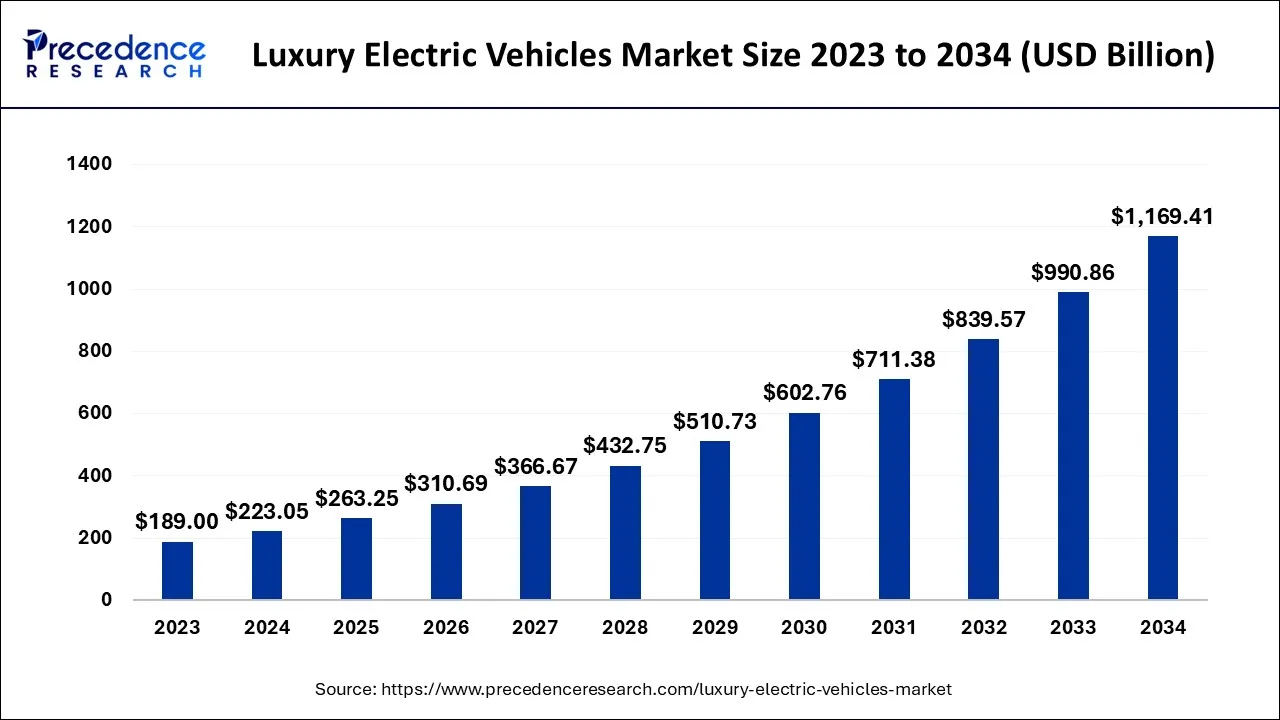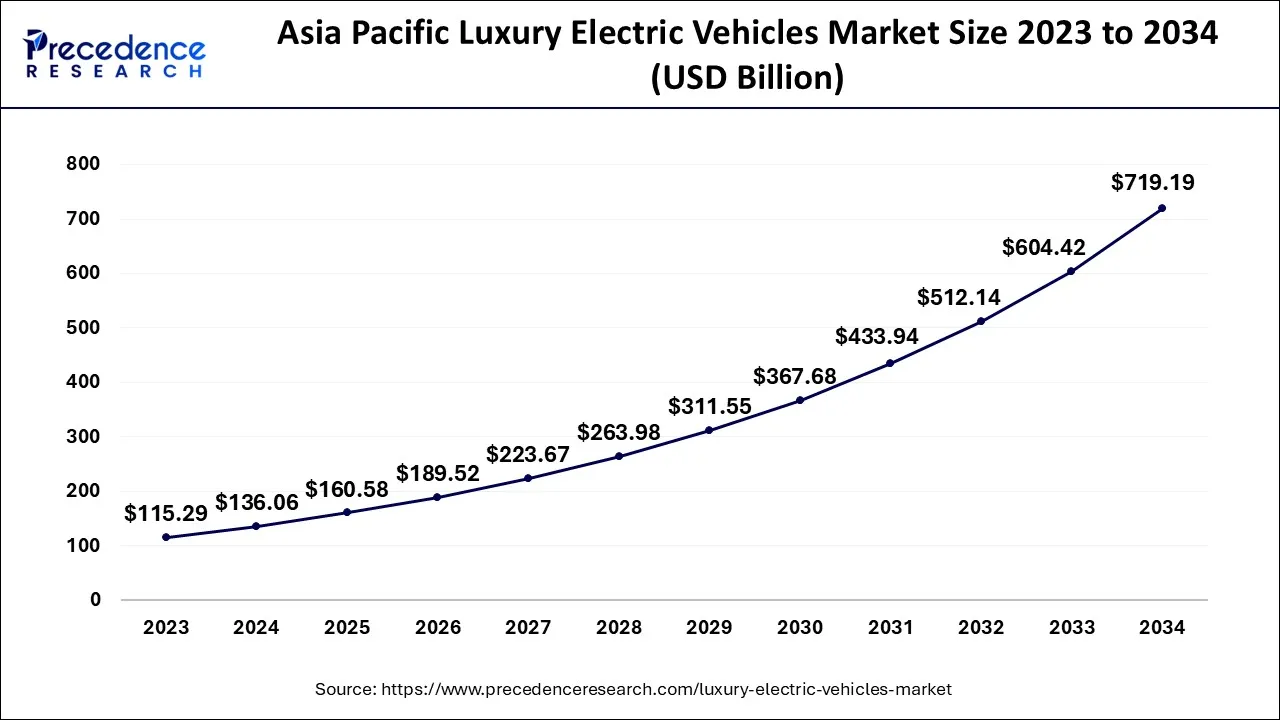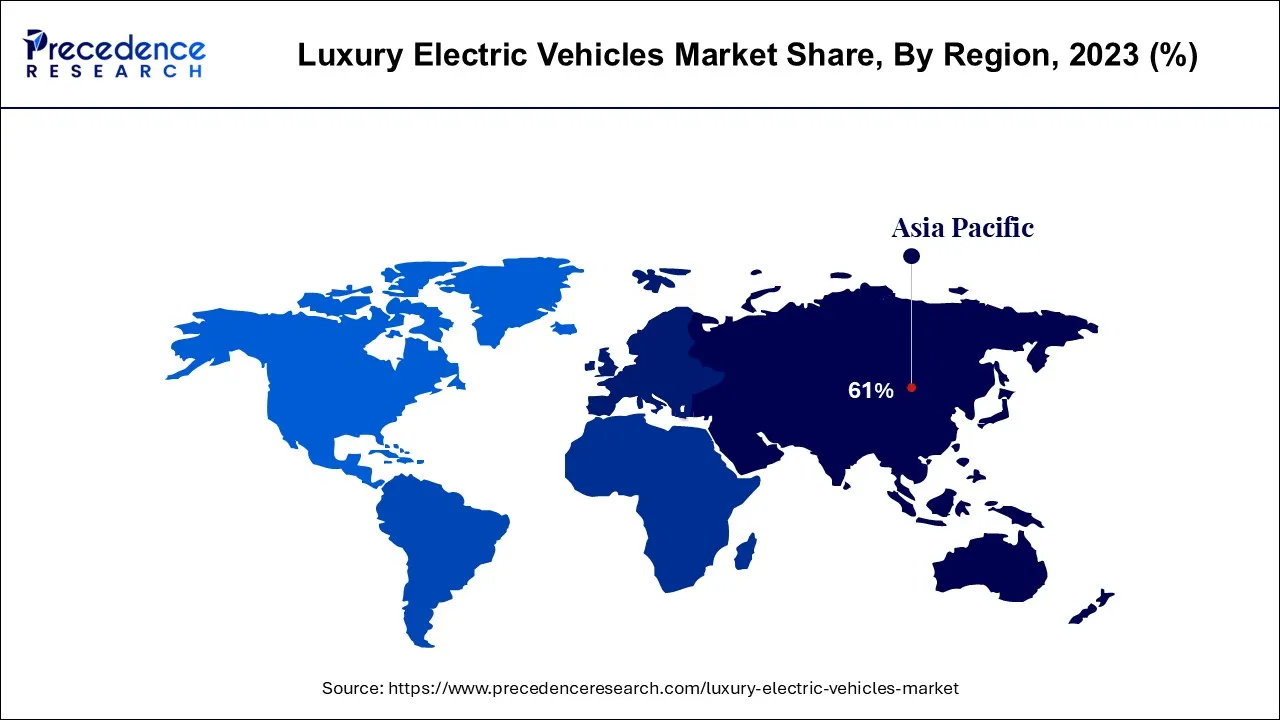May 2025
The global luxury electric vehicles market size accounted for USD 223.05 billion in 2024, grew to USD 263.25 billion in 2025 and is expected to be worth around USD 1,169.41 billion by 2034, registering a CAGR of 18.02% between 2024 and 2034. The Asia Pacific luxury electric vehicles market size is calculated at USD 136.06 billion in 2024 and is estimated to grow at a CAGR of 18.12% during the forecast period.
The global luxury electric vehicles market size is calculated at USD 223.05 billion in 2024 and is projected to surpass around USD 1,169.41 billion by 2034, growing at a CAGR of 18.02% from 2024 to 2034.

The Asia Pacific luxury electric vehicles market size is exhibited at USD 136.06 billion in 2024 and is projected to be worth around USD 719.19 billion by 2034, growing at a CAGR of 18.12% from 2024 to 2034.

Asia-Pacific dominated the luxury electric vehicle market with the highest market share in 2023. The region continues its dominance in the predicted timeframe also due to its increasing prevalence in buying luxury products for maintaining its lifestyle. The increasing population would drive the demand for affordable transportation in the region and this factor will contribute to the expansion of the luxury electric vehicles market in the forecast period.
A country like China had half of the world’s electric vehicle consumers and it is also the hub of the largest electric vehicle manufacturer. The Chinese government announced the subsidies and deduction in taxes for new energy vehicles at the end of 2022.

Japan is as well contributing to the development of the electric vehicle market. They had the best-selling electric vehicles in the worldwide market. The leading automobile manufacturer like Nissan had manufacturing units in the country.
In India, the government interventions for the climatic condition and for reducing the greenhouse emission into the environment strongly support the electric vehicles market. With the use of EV cars, buses, two-wheeler, and three-wheelers.
North America is expected to hold a significant share of the market during the forecast period. The growth of the market is attributed to the increasing spending tendencies on luxury by consumers would drive the luxury electric vehicle market. The automotive industry is an ongoing tremendous technological innovation in the last decades in this region. North America with an annual approach to the production of 15 Million vehicles in 2022. Canada, the United States, and Mexico world together for smooth electrification and transition.
The luxury electric vehicles market refers to the industry sector from the global automotive industry that focuses on the production of high-end, premium electric vehicles. Luxury electric vehicles combine luxurious features and high performance with the latest cutting-edge technology.
Electric vehicles are now considered the future of the automobile sector. Electric vehicles completely consume electricity for refueling and it does not emit any carbon emission into the environment. Electric vehicles are beneficial for the environment though they do not pollute the environment by reducing any carbon emission and shifting consumer preferences towards pollution-free vehicles would rise the trend for electric vehicles. Electric vehicles are more economical for consumers and manufacturers. The technological advancements in electric vehicles would attract consumers to the demand for luxurious electric vehicles.
Increasing disposable income and rising living standards tend to the increasing demand for luxury goods. Luxury electric vehicles are offered segment by the luxury goods market. The demand for luxury vehicles in developing and developed economies would drive the market for the luxury electric vehicle market. Increasing global warming concerns over consumers will likely propel the demand of the market. Increasing governmental interventions for the use of electric vehicles for the environmental concern and relaxing subsidies in taxes for the use of electric vehicle consumers will likely boost the demand for the luxury electric vehicles market.
Luxury electric vehicles consist of several technological innovations for consumers' luxury and safety. Increasing investments by manufacturers in the technologies of electric vehicles is likely to boost the demand in the luxury electric vehicles market. Shift in consumer preferences from conventional vehicles to electric vehicles, manufacturers developed the latest technology and luxury in electric vehicles for a better luxurious driving experience all these factors would contribute to the expansion of the luxury electric vehicle market.
Multiple manufacturers of electric vehicles are currently witnessing a surge in their revenues, this element is also observed as a market trend that can promote the market’s growth.
| Report Coverage | Details |
| Market Size in 2024 | USD 223.05 Billion |
| Market Size by 2034 | USD 1,169.41 Billion |
| Growth Rate from 2024 to 2034 | USD 18.02% |
| Largest Market | Asia-Pacific |
| Base Year | 2023 |
| Forecast Period | 2024 to 2034 |
| Segments Covered | By Propulsion Type and By Vehicle Type |
| Regions Covered | North America, Europe, Asia-Pacific, Latin America, and Middle East & Africa |
Cheaper energy and no greenhouse gas pollution
Increasing disposable incomes and spending tendencies in the millennial generation in the luxury lifestyle would contribute to the growth of the market. The use of electric cars and trucks indicates relatively low levels of greenhouse gas emissions and the resulting impact on global warming. However, if the energy is produced using conventional fossil fuels, electric vehicles do not considerably reduce greenhouse gas emissions when compared to ordinary vehicles. When it comes to cost per mile, using electric energy is substantially less expensive than using fossil fuels, thus using electric automobiles instead of conventional ones will result in fuel savings for the same distance traveled. In terms of greenhouse gas emissions and air pollution, electric automobiles are not the sole option. These would help the market for high-end electric vehicles to expand.
High-cost maintenance
The power in almost all batteries degrades with time. This is also true of the batteries used in electric vehicles. As a result, the range of electric vehicles may decrease as the batteries get older. Another problem with luxurious electric cars is that they can have far lower driving ranges than conventional cars that are powered by fossil fuels. There are now fewer electric vehicles available on the market than conventional automobiles, despite the fact that more automakers are joining the electric vehicle market. These would cause market contraction. Along with this, the maintenance of electric vehicles that carry luxurious features may be more costly than the normal electric cars/vehicles. Such factors hamper their adoption by creating a restraint for the market’s growth.
Government subsidies in taxes drives the market
In many places, the manufacturers of electric vehicles have started focusing on the production of vehicles with luxurious features to offer a better driving experience for the consumers. Additionally, the governments are providing direct subsidies or tax breaks for electric automobiles. Therefore, even if the upfront prices of electric cars may be greater than those of conventional ones, by accounting for such incentives, the price gap between conventional and electric automobiles may be greatly reduced. Such initiatives by the government highlight the growth of the market during the forecast period.
The battery-electric vehicle segment dominated the market with the highest market share in 2023. The segment is expected to continue its dominance with the rising adoption of electric vehicles over conventional vehicles. The main difference between an electric car and one that is regularly powered by gasoline or diesel is that an electric car is pushed by one or more electric motors rather than a gasoline tank, which is how internal combustion engines are generally fueled in these cars. Lithium-ion batteries, which are used to charge the car via a cable after obtaining electricity from the grid, make up the great majority of batteries used in electric vehicles today. Similar to how a mobile phone is charged, an electric vehicle is linked to the grid via a home wall box or a public charging station.
The fuel cell electric vehicle is expected to hold a significant market size in the forecast period. The growth of the market is attributed to the shifting consumer preferences towards clean energy fuel. FCEVs, sometimes referred to as fuel cell electric vehicles (FCEVs), operate just like typical battery-powered electric vehicles (BEVs). The wheels are propelled by electric motors rather than an internal combustion engine. FCEVs have a hydrogen fuel cell as their onboard power source, in contrast to BEVs, which require external power plants to refuel. However, compared to their gasoline-guzzling predecessors, today's fuel cell vehicles can go two to three times farther on a gallon of fuel, and it is predicted that as demand increases, hydrogen fuel prices will fall.
The car segment dominated the market with an accountable market share in 2023. The growth of the segment is attributed due to the increasing adoption of technologies by consumers in the form of electric vehicles. Strong sales of electric vehicles have been attributed in large part to sustained governmental support.
For the upcoming decades, an increasing number of nations have set ambitious goals for the electrification of vehicles, and many automakers have electrification plans for their fleets that go above and beyond legislative goals.
Segments Covered in the Report
By Propulsion Type
By Vehicle Type
By Geography
For inquiries regarding discounts, bulk purchases, or customization requests, please contact us at sales@precedenceresearch.com
No cookie-cutter, only authentic analysis – take the 1st step to become a Precedence Research client
May 2025
October 2024
April 2025
January 2025